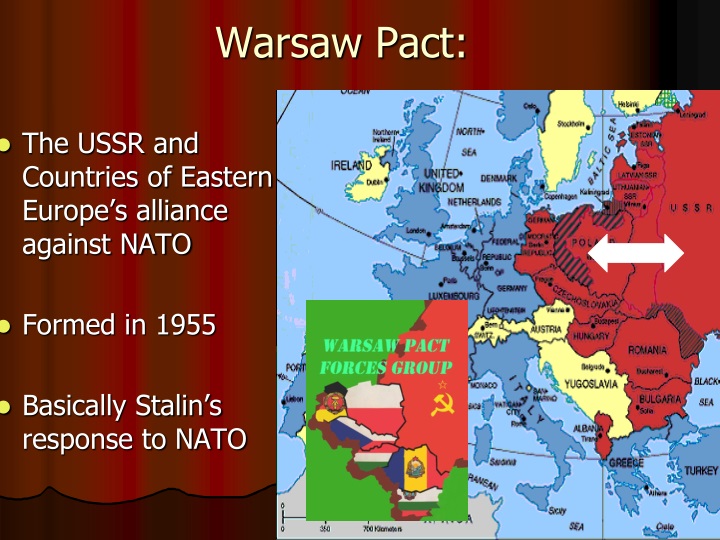
Warsaw Pact Definition
Warsaw Pact definition: 1. A treaty signed in 1955 by the Soviet Union and seven of its European satellites, that established a military alliance for collective security: it was dissolved in 1991 2. These countries, sometimes excluding the Soviet Union, c. The Warsaw Treaty Organization (also known as the Warsaw Pact) was a political and military alliance established on May 14, 1955 between the Soviet Union.
Libor Hajsky—CTK/AP ImagesWhat the North Atlantic Treaty Organization (NATO) is for the Western democracies, the Warsaw Pact was for the and Eastern Europe. The full title is Warsaw Treaty of Friendship, Cooperation, and Mutual Assistance. The treaty was signed on May 14, 1955, by the Soviet Union, East Germany,. (Albania withdrew in 1968. East Germany withdrew in 1990.) The treaty was renewed for 10 years in 1975 and for 20 more in 1985. It was dissolved on July 1, 1991.In 1955 the Soviet Union wanted to establish a strong defense alliance against any potential military or economic threats from the West, especially with a rearmed West Germany as a member of NATO.
Another purpose was to strengthen the hold of the Soviet Union over its Eastern European satellites and to prevent their seeking close ties with the West. One means of maintaining such control was the stationing of Soviet troops and weaponry in Eastern Europe.The presence of Soviet troops led to a revival of nationalism and expressions of hostility toward the Soviet Union in several countries, especially Hungary, Poland, and Czechoslovakia. In 1956 there was an uprising in Hungary that was quickly put down by the Soviets.
In 1968 Warsaw Pact troops were called into Czechoslovakia after that nation’s government had begun lifting restraints on personal freedom. Only Poland’s own declaration of martial law in 1981 saved Poland from invasion by Warsaw Pact forces.The reform policies of in the Soviet Union led to a complete falling away from Communism by the other Warsaw Pact nations in 1989. Soviet troop withdrawals from Czechoslovakia, Poland, and Hungary were pledged in early 1990.
In November 1990 Warsaw Pact and NATO leaders declared that they were “no longer adversaries,” ending the Cold War. The pact’s military structure was disbanded on March 31, 1991, and the political arm, meeting in Prague, agreed to disband three months later.
( See also;;;.). Choose a language from the menu above to view a computer-translated version of this page. Please note: Text within images is not translated, some features may not work properly after translation, and the translation may not accurately convey the intended meaning.
Britannica does not review the converted text.After translating an article, all tools except font up/font down will be disabled. To re-enable the tools or to convert back to English, click 'view original' on the Google Translate toolbar.
What was the Warsaw Pact?
The Warsaw Pact was a collective defence treaty established by the Soviet Union and seven other Soviet satellite states in Central and Eastern Europe: Albania, Bulgaria, Czechoslovakia, East Germany, Hungary, Poland and Romania (Albania withdrew in 1968).
Formally known as the Treaty of Friendship, Co-operation and Mutual Assistance, the Warsaw Pact was created on 14 May 1955, immediately after the accession of West Germany to the Alliance. It complemented the Council for Mutual Economic Assistance, which was the regional economic organisation set up by the Soviet Union in January 1949 for the communist states of Central and Eastern Europe.
The Warsaw Pact embodied what was referred to as the Eastern bloc, while NATO and its member countries represented the Western bloc.
NATO and the Warsaw Pact were ideologically opposed and, over time, built up their own defences starting an arms race that lasted throughout the Cold War.
The Warsaw Pact was declared at an end on 25 February 1991 and the Czechoslovak President, Vaclav Havel, formally declared an end to it on 1 July 1991. Gorbachev’s policy of openness (Glasnost) and restructuring (Perestroika), together with other initiatives, opened the way for popular uprisings. The Berlin Wall fell in November 1989 and communist governments in Poland, Hungary, Czechoslovakia, East Germany, Romania and Bulgaria started to fall.
War of the worlds book. The War of the Worlds is a science fiction novel by English author H. Wells, first serialised in 1897 by Pearson's Magazine in the UK and by Cosmopolitan magazine in the US. The novel's first appearance in hardcover was in 1898 from publisher William Heinemann of London. The War of the Worlds, by H. Wells, is part of the Barnes & Noble Classics series, which offers quality editions at affordable prices to the student and the general reader, including new scholarship, thoughtful design, and pages of carefully crafted extras. Here are some of the remarkable features of Barnes & Noble Classics. The War of the Worlds belongs to the league of immortal books. Tribal wars, civil wars, colonial wars H.G. Wells managed to raise a phenomenon of war to the higher interplanetary level. The air was full of sound, a deafening and confusing conflict of noises the clangorous din of the Martians, the crash of falling houses, the thud of trees, fences, sheds flashing into flame, and the crackling and roaring of fire.
The break-up of the Warsaw Pact was shortly followed by the dissolution of the Soviet Union in December 1991.